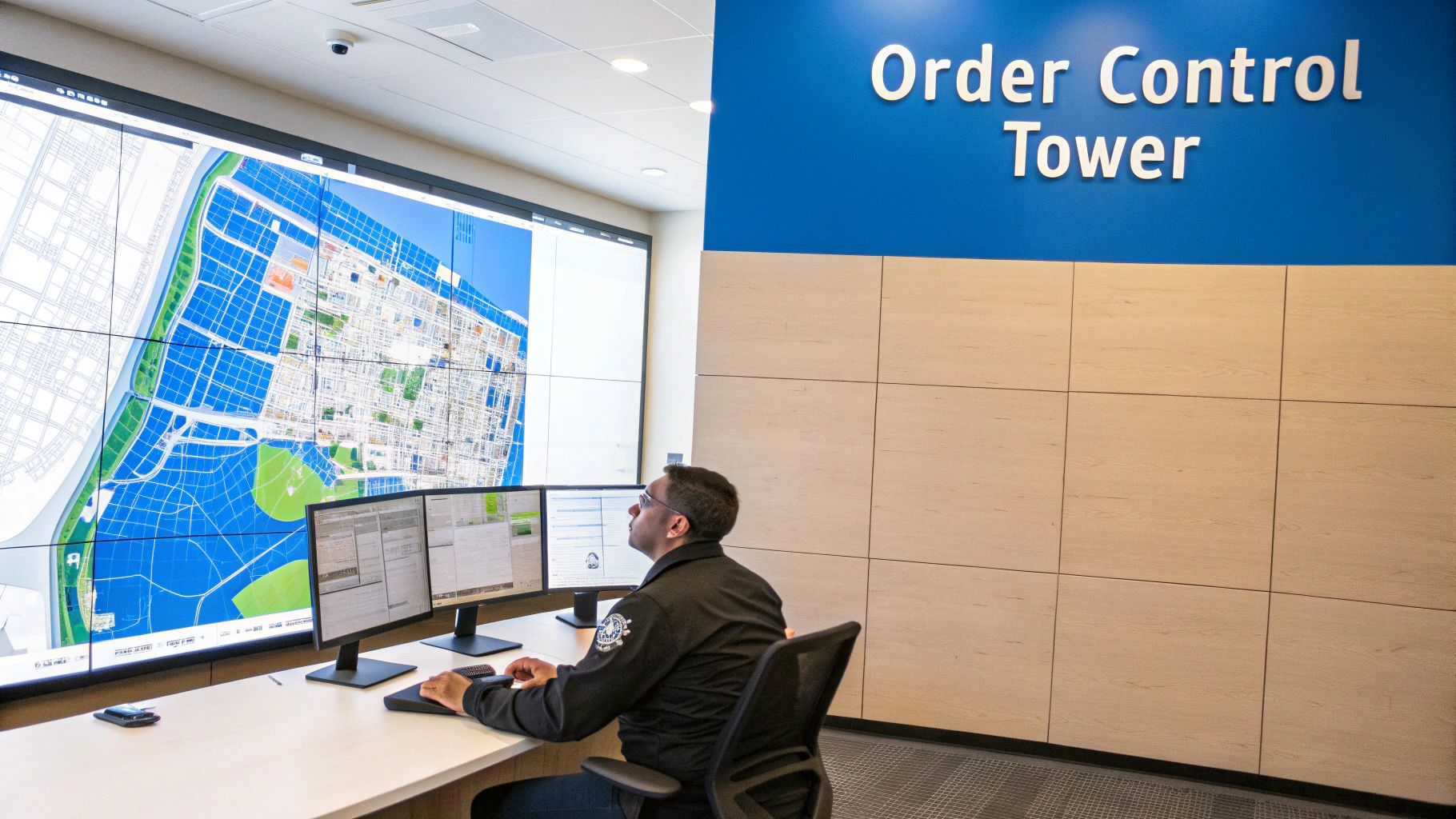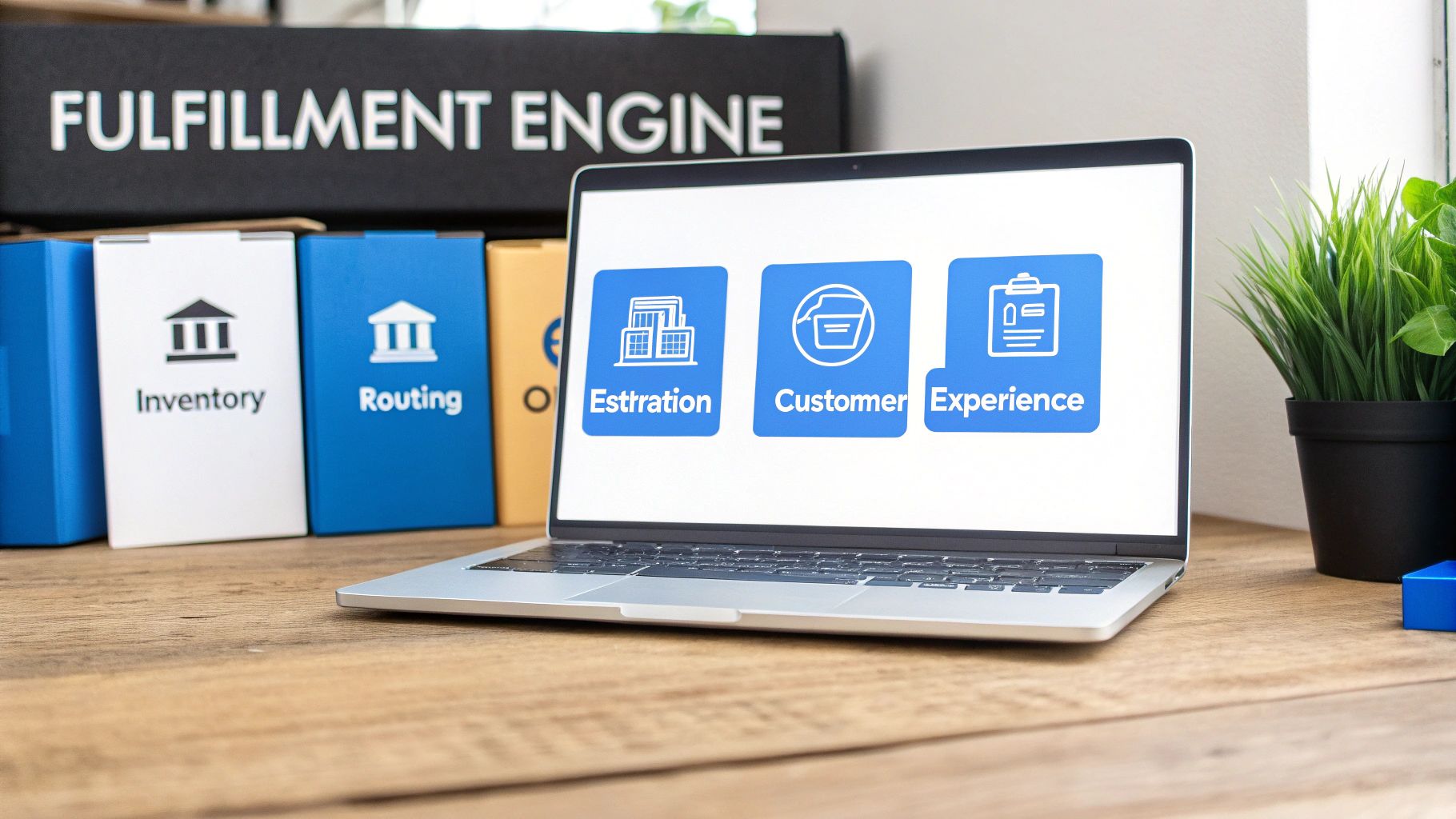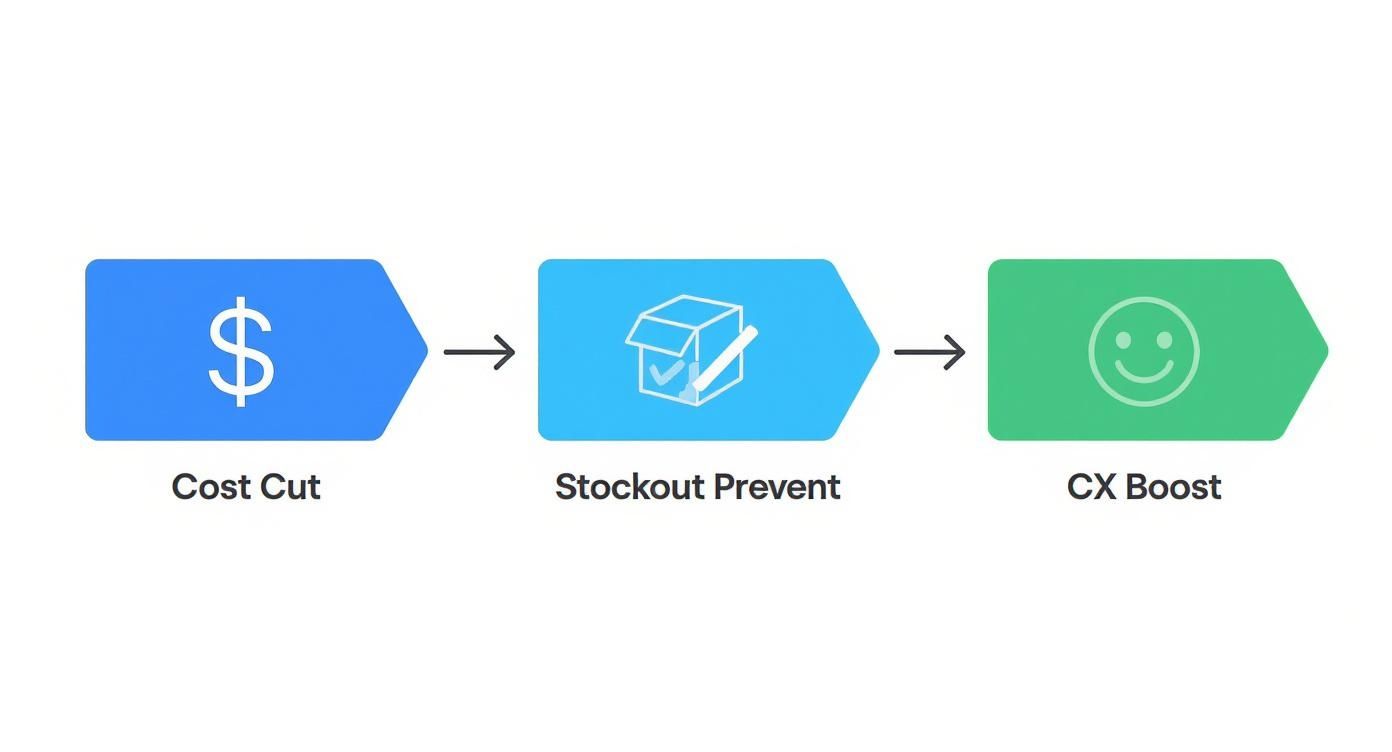Distributed Order Management, or DOM, is a powerful system that intelligently figures out the best possible location to fulfill a customer order from, all based on a set of business rules you define. It gives you a single, real-time command center view of your entire inventory network—every warehouse, retail store, and partner facility you use.

Think about a traditional fulfillment process. It’s a bit like a one-way street. An order comes in, and it automatically gets sent to your main warehouse, no matter where the customer lives. This method works, but it's often slow and expensive.
A customer in California might end up waiting days for a package that’s shipped from a warehouse in New York, even if you have a retail store just down the road from them with the exact same product sitting on the shelf.
That's where distributed order management comes in. It turns that one-way street into a dynamic, multi-lane highway system for your orders. A DOM acts like an intelligent air traffic controller, analyzing every possible fulfillment route in an instant to find the most efficient path.
Instead of just defaulting to a single warehouse, a DOM system looks at every single place you store inventory—your 3PLs, your brick-and-mortar shops, even your suppliers' warehouses—and makes a strategic call on where to ship from.
To really see the difference, it helps to put the two approaches side-by-side. The table below breaks down how a linear, traditional process stacks up against a dynamic, distributed one.
As you can see, the shift to a DOM isn't just a minor upgrade—it's a fundamental change in how you approach getting products to your customers.
A DOM system is constantly weighing multiple factors to make the smartest fulfillment choice for every single order. Its core job is to strike the perfect balance between three critical goals: cutting operational costs, speeding up delivery, and making the customer happy.
This is a huge step up from a basic order management system, which is typically designed to just process orders one by one in a straight line.
A DOM system’s primary function is to optimize fulfillment, allocation, and distribution across all inventory locations and channels. The result is higher inventory utilization, lower fulfillment costs, and smarter omnichannel operations.
By having a complete, unified view of your stock, a DOM can pull off complex fulfillment strategies that a traditional system just can't handle. This kind of power is no longer a luxury reserved for giant retailers; it’s quickly becoming an essential tool for any modern brand that wants to compete on speed and convenience.
For every single order that comes in, it instantly answers critical questions, like:
This intelligent, automated decision-making is really the heart of what distributed order management is. It’s not just about managing orders; it's about strategically orchestrating them across your entire network to build a real competitive advantage.

To really get what a DOM does, you have to look under the hood. At its heart, a distributed order management system is built on four pillars that work in lockstep to create a powerful, automated fulfillment machine. Each piece has a specific job, from seeing your inventory to making your customers happy.
Let's break down these core components and see how they actually work for a growing brand.
Think of this as the system’s eyes. Centralized inventory visibility gives you a single, unified view of every single product you own, updated in real time. It doesn't matter if an item is sitting in a central warehouse, on a retail shelf, or at a 3PL partner's facility—the DOM sees all of it, all at once.
This complete picture is the bedrock for every decision the system makes. Without it, you’re flying blind, risking stockouts in one channel while products collect dust in another. With it, you unlock the full potential of your entire inventory pool for every single sale.
This is the strategic brain of the operation. The moment a customer clicks "buy," the DOM's intelligent order routing logic kicks in, instantly analyzing all the possible ways to fulfill that order. It uses a set of business rules—which you get to define—to figure out the absolute best location to ship from based on what matters most to you.
This isn’t a one-size-fits-all process. The system weighs multiple factors to make the smartest choice for each unique order. You can configure these rules to optimize for different goals:
For example, a brand might set a rule to always ship from the location closest to the customer—unless shipping from a slightly farther warehouse would get the entire order into a single box, saving money on split-shipment costs.
The real power of a DOM lies in its ability to automate these complex decisions in milliseconds, applying sophisticated logic that would be impossible to manage manually at scale.
This level of automation is what really changes the game. It turns order fulfillment from a simple, linear task into a dynamic, strategic advantage that directly impacts your bottom line and keeps customers coming back. This intelligence is often what separates a true DOM from a standard Warehouse Management System, though it's helpful to understand both. You can check out a detailed warehouse management software comparison guide to see how these systems differ and where they overlap.
If routing is the brain, then orchestration is the hands of the system. This component coordinates all the moving parts across your entire fulfillment network. Once the DOM decides on the best location, it instantly communicates the necessary instructions to that specific warehouse, retail store, or 3PL.
It makes sure the right instructions are sent, the order is picked and packed correctly, and all the shipping information is relayed back. This seamless coordination is crucial for more complex scenarios like ship-from-store or multi-location shipments, ensuring everyone in the network is working from the same playbook.
Ultimately, all these back-end components work together to power front-end features that your customers see and appreciate. A DOM provides the data needed to offer accurate, reliable delivery estimates right at checkout. It also makes popular omnichannel services that customers now expect possible.
These tools enable options like:
Together, these four components create a closed-loop system that optimizes every single step of the order lifecycle, from the first click to the final delivery.
In a world overflowing with online shopping choices, just having a great product isn't enough. Meeting—and exceeding—customer expectations for delivery is the new battlefield. Today's shoppers want their orders fast, they want shipping to be cheap (or free), and they want flexible options. If you can't deliver, they'll find someone who can in a single click.
This is exactly where a distributed order management (DOM) system stops being a "nice-to-have" piece of tech and becomes a core strategic asset. A DOM tackles the biggest fulfillment headaches head-on, transforming your supply chain from a simple cost center into a powerful competitive advantage. It helps you move beyond the old-school "ship everything from one big warehouse" model and starts leveraging every single piece of inventory you own, no matter where it's sitting.
One of the first and most powerful impacts of a DOM is its ability to dramatically cut down your shipping bill. By intelligently routing each order to the fulfillment location closest to the customer—whether that’s a massive distribution center or a small retail store—a DOM instantly minimizes the shipping zones your packages have to cross.
This one change creates a massive ripple effect across your operations:
This isn’t just a minor operational tweak. It's a fundamental shift that makes your entire business more efficient and your checkout offers way more compelling.
There’s almost nothing more frustrating for a customer than finding the perfect product only to be met with that dreaded "out of stock" message. A DOM is your best defense against this scenario. It works by creating a single, unified view of all your inventory, everywhere.
An item might be sold out in your main e-commerce warehouse, but what if there are five of them sitting on a shelf in your Chicago store? A DOM sees that and can automatically use that store's stock to fulfill the online order.
A DOM turns every single stock point—from warehouses to back rooms—into an active part of your e-commerce strategy. It ensures you can sell through your entire inventory and capture every possible sale.
This prevents lost revenue and stops customers from immediately bouncing to a competitor's site. As the 2025 Gartner® Market Guide points out, these systems are absolutely vital for any company trying to meet the high expectations for a seamless omnichannel experience. With commerce spreading across more channels than ever, you need that real-time inventory visibility just to keep up.
At the end of the day, a DOM is all about creating happier customers who keep coming back. By enabling faster deliveries and offering flexible fulfillment choices like Buy Online, Pick-up In-Store (BOPIS) or ship-from-store, you give people the convenience they've come to expect.
This creates a far superior experience that genuinely builds brand loyalty. When customers learn they can count on you for fast, reliable, and convenient delivery, they’re much more likely to choose you for their next purchase. You start turning one-time buyers into loyal, long-term advocates for your brand.
To really get a feel for what distributed order management is, let's walk through a real-world scenario. We'll follow a single order from the moment a customer hits "buy" all the way to their doorstep, showing how the system makes intelligent decisions at every turn.
Picture this: a customer in Denver orders a popular skincare set from your website. The second their payment goes through, the DOM system jumps into action. Instead of just defaulting the order to your main warehouse in New Jersey, it instantly scans your entire fulfillment network.
This is the system’s first and most critical job: creating total inventory visibility. It sees every single unit you have, wherever it is.
Now the magic happens. The DOM's "brain"—its routing engine—takes that real-time inventory data and applies your brand's specific business rules to find the best fulfillment option. Let's say your main goal is to minimize shipping costs and delivery time.
The system instantly weighs each option against that goal:
Without a single person needing to lift a finger, the DOM makes the decision and automatically routes the order to the Salt Lake City 3PL. It sends all the necessary pick, pack, and ship instructions, turning a complex logistical choice into a simple, automated action.

This simple flow is how a DOM delivers on its promises—cutting costs, speeding up delivery, and ultimately, making customers happier.
But what if things aren't so simple? What if the Salt Lake City location only had part of the skincare set in stock? This is where a DOM truly shines, leaning on advanced business process automation software to navigate tricky fulfillment logic.
In that situation, the DOM would consult its secondary rules. Your brand might have a rule programmed that says, "Avoid split shipments unless absolutely necessary." Splitting an order creates a disjointed customer experience and doubles your shipping costs for a single sale.
So, the DOM re-evaluates. It determines that sending one complete package from the Chicago store is the better strategic move. The slightly higher shipping cost is a small price to pay to avoid the frustration and expense of two separate shipments. This kind of automated intelligence is what keeps your operations humming.
It ensures every single order is fulfilled in the most strategic way possible, constantly balancing costs against customer satisfaction. This is why a solid DOM is so closely tied to inventory management. In fact, learning how to optimize your business with a real-time inventory management system is essential, as that data is the fuel for any DOM's decision engine.
By automating these thousands of daily decisions, a DOM transforms order fulfillment from a reactive, manual process into a proactive, strategic advantage that strengthens the bottom line.
From your customer’s point of view, none of this complexity is visible. All they know is that their order arrived faster than they expected. That seamless experience builds trust and turns one-time buyers into loyal fans. That's the practical magic of distributed order management: solving tough logistical puzzles to create simple, satisfying customer experiences.
Thinking through these key areas upfront will save you from common headaches and make for a much smoother transition. This isn't about flipping a switch; it's about laying a solid foundation for smarter, faster fulfillment across your entire business.
A DOM doesn't work in isolation. Its real magic comes from its ability to talk to all the other critical systems that keep your business running. Before you even think about implementation, you have to plan out how these integrations will work.
Your main connections will be:
Think of these integrations as digital handshakes that let data flow freely. They ensure your DOM has all the info it needs to make those intelligent routing decisions. For brands that lean on outside partners, knowing how to choose a 3PL for your business is a crucial first step, because their tech capabilities will make or break your DOM project.
The success of a DOM hinges on its ability to act as a central hub, connected to a reliable, real-time flow of data from every part of your operational ecosystem.
A DOM is only as smart as the data you feed it. If your inventory numbers are off or lag behind reality, even the most sophisticated routing logic will fall flat. Data integrity is non-negotiable.
This means getting your inventory counts right everywhere—in your warehouses, on your retail shelves, and at your partner facilities. The system needs a true, up-to-the-minute picture of what's on hand to avoid overselling and make the right fulfillment call. This often means tightening up your processes, like running regular cycle counts and being disciplined about how you receive new stock.
Finally, every business has to face the classic "build vs. buy" debate.
Building a custom DOM from the ground up gives you total control, but it demands a mountain of resources, deep technical expertise, and a commitment to ongoing maintenance. Honestly, this path is usually reserved for massive enterprises with incredibly unique, complex needs.
For almost every growing brand, buying a modern, cloud-based DOM solution is the smarter, more practical choice. These platforms get you up and running faster, have lower upfront costs, and come with continuous updates and support from the vendor. They give you all the core power you need to optimize fulfillment without the massive headache of an internal development project.
As brands start digging into what distributed order management is all about, a few practical questions always pop up. It’s a big leap from how fulfillment used to work, so let's clear the air on some of the most common points of confusion.
Think of this as your quick guide to understanding where a DOM fits into the e-commerce world and whether it’s the right next step for your business.
An Order Management System (OMS) is like a straight-line assembly worker. It takes an order and, most of the time, just sends it to one designated warehouse for fulfillment. It’s a basic command center that follows the same script every single time. It manages orders, but it doesn't really think about them.
A Distributed Order Management (DOM) system is the smarter, more strategic evolution of the OMS. Its real magic lies in its ability to see your entire inventory network—warehouses, retail stores, 3PLs, you name it—and apply smart rules to send each order to the best possible fulfillment location.
In short, while an OMS simply processes orders, a DOM strategically orchestrates them to maximize efficiency, cut down on shipping times, and save money.
This is a classic misconception left over from when the technology was new and incredibly expensive. While the giant enterprise retailers were certainly the first to get on board, things have changed in a big way. Modern, cloud-based (SaaS) DOM solutions are now well within reach for growing mid-market brands and even ambitious small businesses.
The need for a DOM isn’t really about your company's size; it’s about the complexity of your fulfillment operation. If you sell across multiple channels or hold inventory in more than one place—say, a main warehouse plus a couple of retail stores—you're exactly the kind of business that stands to gain from a DOM.
The right time for a DOM is when the complexity of your sales channels and inventory locations begins to outpace your ability to manually make the smartest fulfillment decisions for every single order.
A DOM has a direct and powerful impact on the customer journey, turning your back-end operational wins into front-end benefits that shoppers truly notice and value. It makes their experience better by:
Ready to stop worrying about logistics and start focusing on growth? At Simpl Fulfillment, we handle the complexities of order fulfillment so you can get back to what you do best—building your brand. Discover how our reliable, fast, and transparent 3PL services can help you scale at https://simplfulfillment.com.